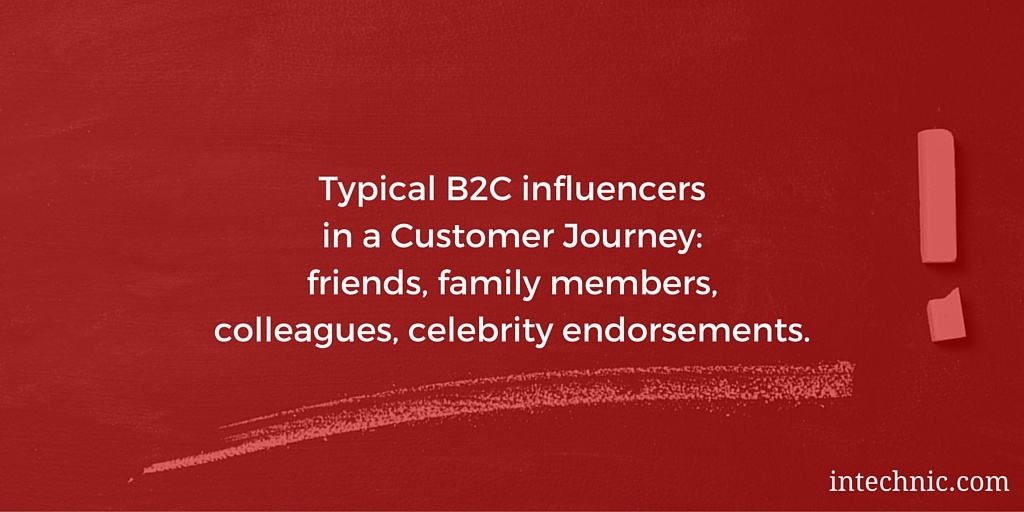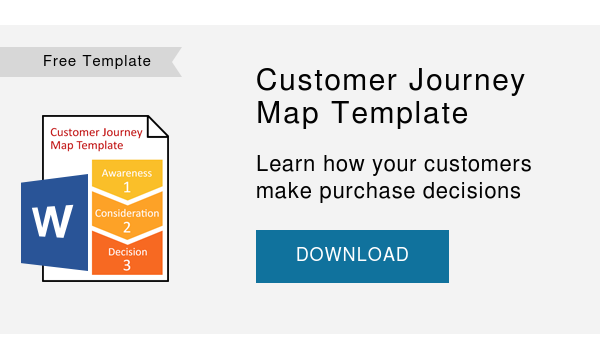 Continued from: How to Create a Customer Journey Map: Tools & Templates
Continued from: How to Create a Customer Journey Map: Tools & Templates
Customer Journey Mapping Process
We covered the process of Customer Journey Mapping in my previous article: How to Create a Customer Journey Map. Please refer to that article for Customer Journey fundamentals as well as step-by-step directions on how to map one. To help you get started, download the Customer Journey Map Template which includes an “empty” map template with some examples.

This article expands into more tips and gives multiple B2B and B2C examples that you can apply to your particular business. You will find these particularly useful if you are already in the process of collecting information or currently mapping your Customer Journeys.
Stages of the Customer Journey
Before we dive in, let's take another look at the stages of a Customer Journey. As a reminder, the Customer Journey is the buyer's process leading up to a purchase. This process happens every time and with every purchase, with something as small as lunch or as expensive as marketing automation software. Customer Journeys consist of the following three stages:
|
You get hungry.
|
"What do I feel like eating that’s quick and nearby?"
|
"I will try this new place my friend recommended"
|
|
You break your phone.
|
"What phones have the best camera? Where can I see them in person?"
|
"I love the features and price. My friends recommended it highly."
|
|
Your boss wants you to generate more sales leads.
|
"What marketing tools can save time? How can I produce better results as a one-person marketing team?"
|
"My boss approved the budget for this marketing automation solution because I was able to demonstrate ROI."
|
Decision Makers vs. Influencers: What's the Difference?
When mapping out your Customers’ Journeys, it is very important to account for which personas are decision makers (someone who has the power to make the final decision) and which are influencers (someone who makes recommendations to a decision maker). It's easiest to identify these roles when interviewing customers so that you can map out your Customer Journeys correctly from the start. The following are the main distinctions you want to keep in mind:
Decision Makers
- These personas typically make the final purchasing decision.
- There can be more than one decision-maker.
- They often have control over their budgets and decide how to spend the money.
- They often rely on influencers for recommendations.
Consider the three examples from above. When buying lunch for yourself or a new smartphone, you are the sole decision-maker. When buying expensive marketing automation software, the decision maker is your boss.

Influencers
- These personas don't have the authority to make purchasing decisions.
- They act as advisors to decision-makers and make recommendations to them.
- They can be a powerful ally or an even more powerful adversary.
- In B2B, they are often tasked with doing research and vetting potential vendors.
Going back to the examples, when buying a new smartphone, your decision was influenced by your friends’ recommendations. When buying marketing automation software, you influenced your boss' decision.
B2C Customer Journey Tips
B2B and B2C Customers’ Journeys are often very different. The same people can behave differently, depending on the environment they are in – business or personal. Consider the following dynamics, frequently observed in business-to-consumer (B2C) situations:
- Decisions about small purchases such as personal-use items or services (lunch, clothing, food, personal electronics, beauty salons, gym memberships, etc.) are typically made by a single decision-maker. Influencers (friends or family) play a lesser role, usually in the form of a recommendation that may influence the decision.

- Decisions about large purchases that affect multiple people, whether they are items or services (houses, cars, vacations, babysitters, etc.), are almost always made by multiple decision-makers. In these cases, you have multiple people making decisions or strongly influencing them. For example: everyone living in a house wants to have a say in choosing which house to buy and they will scrutinize this purchase extensively. You will need to create personas for all decision-makers and attempt to understand what affects their individual decisions, in order to secure their vote.

- Impulse purchases are more common in a B2C environment where consumers are more likely to be influenced by their feelings, emotions and instincts. Personality traits play an important role in these types of decisions. Consumers will buy something they “want” but not something they necessarily “need”. A good example of this is clothing; people don’t always necessarily need new clothes, but they like how new clothes make them feel.

Download our Customer Journeys Template & Examples for complete B2C examples of a Customer Journey.
B2B Customer Journey Tips
Similarly, the decision-making process in a B2B environment has elements that differ from B2C. For example, in a typical firm, with 100-500 employees, an average of 7 people are involved in most buying decisions (Gartner Group). In these instances, it is important to understand how decisions are made, who all decision-makers are and how they interact with each other. Consider the following business-to-business situations (B2B):
- Decisions that fit within the spending ability of a business professional (within their pre-approved or allocated budget) are often made directly by that decision maker. This normally includes inexpensive products or services that provide for the individual's needs or those of a small group (inexpensive software, office supplies, professional consultations, etc.).
- Sometimes, decision-makers ask for recommendations from their colleagues/associates who are subject matter experts before making a purchase within their realm of expertise. For example, they ask a fellow marketer friend or head of the IT department for an opinion on purchasing a new marketing automation software. Consider creating influencer personas for such colleagues and associates.

- Large purchases might require a second signature or the approval of a "boss" when they are outside an individual's spending ability (like in the example with the marketing automation software). In this case, create a persona for the supervisor (boss) and seek to understand how they will go about making their decision. This is why it is important, in Customer Interviews, to ask about an individual's supervisor (if they have one) and their role in the decision-making process.
- Decisions on large purchases such as items/services that affect a team or the entire company are often made by committees, where each member has a vote and decisions are made collectively. Examples of this scenario include new company websites, ERP software or new office spaces. In these circumstances, it is imperative to understand who is on the committee, how they make decisions and what influences those decisions, then create a separate Customer Journey for each member (persona).

- Business professionals don't typically like taking risks so making a "decision by committee" is a form of hedging risk. That way, a single individual does not assume full responsibility if something goes terribly wrong.
- Business purchases often impact business results so smart business professionals set expectations for ROI and use measurable KPIs (Key Performance Indicator). It is important to know how each persona's results are measured so that, in the case that your solution helps them with their job, objective KPIs can be used to measure it.
- Impulse purchases are less common in a B2B environment. Business professionals tend to make business purchases more objectively while looking at ROI, risks vs. benefits, KPIs, etc.
 Download our Customer Journey Map Template below for complete B2B examples of a Customer Journey.
Download our Customer Journey Map Template below for complete B2B examples of a Customer Journey. 
Onstage vs. Offstage Situations
When evaluating steps in the Customer Journey, it is important to distinguish onstage situations (visible to the customer) and offstage (external factors going on behind the scenes). Going back to our smartphone buying example, the customer went to the store to look at phones – this is onstage because the customer is interacting directly with the selling company and the product. As it applies to marketing automation software, the customer's boss' decision could have been affected by external budget restrictions impacting the amount of money the company could spend on the software (offstage). The budget restriction has nothing to do with interacting with the selling company or the product, but it impacts the final decision. Make sure you understand how offstage situations could impact decision-making. While some of these situations may be outside the scope of your Customer Journey, you don't want to be surprised by a common offstage/external trend that could influence a purchase.
Focus on Content over the Format
If you Google Customer Journey examples, you will find dozens of colorful diagrams and flow charts. I am often asked about the best format of a Customer Journey Map and my answer is always the same: start by writing it out. Focus on covering all stages and steps. Write it out as a story. Once you have a story, you can create a simpler, visually appealing diagram or flow chart to help support it. While diagrams are useful to visualize the flow of the Customer Journey, you shouldn't substitute a Journey with a diagram or you will lose a lot of important detail. You can always go from more detail to less detail but not the other way around.

Our Customer Journey Map Template is simple yet effective. You can download it below: 
Continuously Update Your Customer Journey
I talked about the importance of validating Customer Journeys in the previous article. At the same time, it is equally important to update your Customer Journeys at least once a year. Your competitors, markets and customers evolve, as do they Journeys. Relying on an outdated Customer Journey means your entire marketing strategy could also be outdated. Once a year, ask your sales team to review your Customer Journeys and ask them the following questions:
- Are we missing any personas or persona types (decision-makers or influencers)?
- Are we missing any common situations we haven’t accounted for?
- Is there anything that doesn’t seem right?
If potential changes or mistakes are identified, you will need to revisit your Customer Journeys and potentially plan follow-up research or additional interviews. 
Next Steps
Now that you have completed your Customer Journey, you should look at your online competition with the help of competitive analysis and analyze your website's strengths, weaknesses, opportunities and threats using SWOT analysis.


